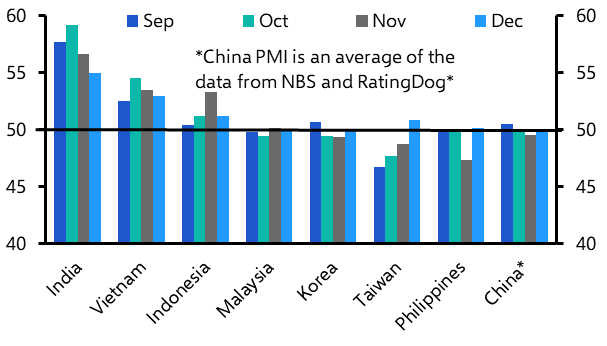The debate about the role of the dollar in the global economy is an old one. Over the years it’s been given fresh life by events including the creation of the euro, China’s rise and the Global Financial Crisis.
Most recently, the decision by the US and its allies to impose severe financial sanctions on several Russian individuals and institutions, and effectively freeze a portion of the central bank’s foreign exchange reserves, has spurred fresh talk about the end of the dollar’s dominant role in the global economy.
As has always been the case, much of the debate has been muddled, imbued with exaggerated claims that fail to consider practical considerations.
A lot of attention has focussed on the dollar’s role as the world’s reserve currency. As it happens, the share of foreign exchange reserves held in dollars has declined over the past few decades, from around 70% in 2000 to about 60% today. But the dollar remains dominant. Around 20% of reserves are currently held in euros, the second most popular reserve currency, and only 2.5% are held in renminbi. This dominance creates foreign demand for dollar-denominated assets and, all other things being equal, lowers US borrowing costs. This is part of the so-called “exorbitant privilege” of issuing the world’s reserve currency.
However, it is the dollar’s role as the dominant currency for settling cross-border transactions – and by extension the US financial system’s role as the plumbing for the world economy – that is more important from the perspective of geo-political influence.
Data on the currencies used to settle international transactions are difficult to come by, but we do have figures on the denomination of transactions processed through the Swift messaging system. This suggests that almost half of transactions are settled in dollars, even though the US accounts for only 10% of world trade. (See Chart 1.)
Chart 1: Currency Denomination of International Payments via Swift
(exc. Intra-euro-zone transactions, %)
 Source: Swift
Source: Swift
That disproportionate share means that the US wields enormous power over global trade and financial flows. It has now brought that power to bear against Russia – but it has also exposed how vulnerable other economies are to the financial mercy of Washington.
Russia’s experience will have caused concern in those countries that are not strongly aligned with the US. Some commentators have suggested that this will lead to a more general push by countries to disentangle themselves from the US financial system and reduce their use of the dollar.
But attempting to do so wouldn’t get them very far. An international currency has to fulfil three functions: it must act as a unit of account, a medium of exchange, and a store of value.
Any currency could act as a unit of account for the purposes of global trade: exports can be priced in renminbi, real or rand, just as easily as they are in dollars. But for a currency to be widely used as an international medium of exchange, it must be readily and cheaply available around the world. In turn, that depends on foreigners being willing to hold it in large volumes: in other words, it must function as a store of value. Foreign demand for dollar assets creates the deep and liquid markets that underpin the dollar’s global dominance.
The dollar is not the only currency that could perform this role. But any alternative would need to share similar attributes: it would be backed by strong and stable institutions, and issued by a central bank that operated an open capital account. That explains why as China and Russia have tried to reduce their use of the dollar in bilateral trade, they have adopted the euro, rather than the ruble or renminbi. (See Chart 2.)
Chart 2: Currency Used for Russian Exports to China (%)
 Sources: Central Bank of Russia, Capital Economics
Sources: Central Bank of Russia, Capital Economics
And in practice, even the euro has struggled to make headway against the dollar where these geopolitical pressures aren’t present: network effects push towards a single medium of exchange. The need to act as a store of value also explains why Bitcoin (or other cryptocurrency) is unlikely to supplant the dollar.
The sanctions imposed on Russia will accelerate the development of bilateral trading blocs that use alternative currencies. In particular, it’s likely that over the next decade more trade between China and its allies will take place in renminbi. But this bloc is likely to account for a relatively small share of the global economy and even then, it’s unlikely that the majority of its trade will take place in renminbi.
Fast forward ten years and the most likely outcome is a more fragmented global financial system – but one that still has the US dollar at its core.
P.S. The dollar’s role has also been underpinned by the vibrancy of the US economy – but is that growth outlook now wobbling? Our US Recession Trackers are now on CE Interactive active, our data platform, presenting our proprietary models gauging the probability of a US recession out 12 months (CEI subscribers get full access to the underlying data). The trackers include our Treasury yield curve models which illustrate our view that the risk of recession looks low, despite market concerns about recent inversions along the curve.
In case you missed it:
- We unpack the economic and market consequences of the radical shift in Europe’s energy policy in the wake of the war in Ukraine.
- Our Senior Asia-Pacific Economist, Marcel Thieliant, argues that there is a growing risk that the BoJ will be forced to abandon yield curve control.
- Our Europe team argues that euro-zone exports will slow to a crawl this year – but that high inflation will force the ECB to tighten by more than most analysts anticipate.




